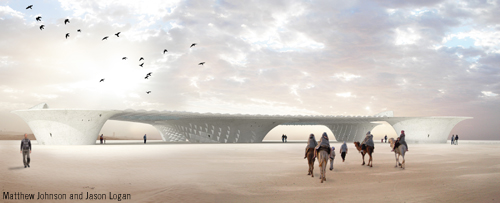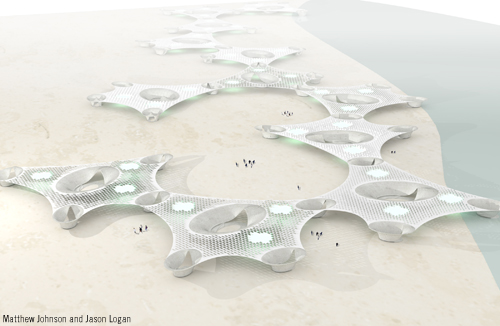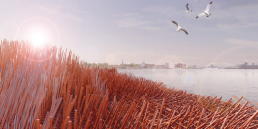Matthew Johnson and Jason Logan
Designed for Site #2 in Abu Dhabi, between Saadiyat Island and Yas Island.

Design Submission for the 2010 Land Art Generator Initiative Design Competition
Artist’s descriptive text:
The Prism Cloud hovers over the desert, alternately casting shadows and spectral light on its surface. It attempts to render the invisible visible, calling attention to atmospheric elements that might otherwise go unnoticed. Within the empty context of a desert, the Prism Cloud creates an experiential fullness. Light is made visible by splitting prismatically into its various colors. Wind is made visible and audible as the canopy ripples and moves. The sky and the sand are framed in experiential oases made from concrete, which act as focal points and structure for the canopy. The canopy also harnesses solar energy through its array of photovoltaic cells. The project finds beauty in the extreme nature of the landscape, amplifying its effects. The elemental qualities of the site become focused at the point where the desert meets the water under a vast sky.
Mirage: Bent Light
From the New Khalifa Highway, the Prism Cloud appears as a mirage, an optical trick. Its reflective upper surface shimmers, seeming to bend the light. This effect acts as a kind of beacon, drawing visitors to the site.

Canopy: Shaded Light
The cable net canopy forms a tensile structure. As wind moves over the cable net, it flexes, creating moving shadows and prismatic light. The northwest wind is drawn through the structures of the photovoltaic cells, cooling the shaded space even further. Because the primary structure is a cable net suspended above the desert, the fragile ecology is preserved and allowed to shift and evolve.

Prism: Diffracted Light
The canopy of the Prism Cloud is constructed from a steel cable net attached to concrete piers (oases.) Embedded within the cable net are alternating glass prisms and photovoltaic cells. The prisms split the sunlight into spectral colors, which are refracted onto the surface of the desert below. These create pools of multicolored light through which visitors can wander. Photovoltaic cells are pyramidal structures that absorb solar energy on their south sides, and act as wind-scoops on their north sides.

Oasis: Framed Light
The unordered field of the prism canopy is punctuated by five concrete oases. As visitors wander from under the canopy into each oasis, they are made aware of the elemental condition of the desert. The sky is vast and framed by the upper edge of the oasis. Sunlight fills the space, while the ground is either pure sand or water, creating a plane of a singular material. Sky, sand, and the meridian in between.

Environmental Impact Statement
The Prism Cloud is minimally invasive to its environment and the surrounding desert ecology, since the only point at which it touches the ground is at the concrete piers, which can be spaced far apart. The primary structure is a cable net that never touches the ground.
Related Posts
2 Comments
Add comment Cancel reply
This site uses Akismet to reduce spam. Learn how your comment data is processed.


[…] Via: LandArtGenerator […]
[…] be spaced far apart. The primary structure is a cable net that never touches the ground. Source: Land Art Generator Initiative Reageer […]